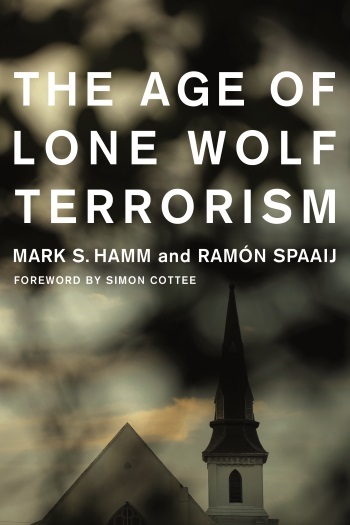The Meaning of Lone Wolf Terrorism

“The study of lone wolf terrorism takes a significant leap forward in this important book. Hamm and Spaaij provide a thoughtful analysis and critical insights about the nature of lone wolf terrorism and terrorists. The book is a must-read for scholars, policymakers, and law enforcement officials.”
~Steven Chermak, Michigan State University
Federal authorities are treating the July 28 Giloroy Garlic Festival Shooting and Saturday’s mass shooting in El Paso, Texas as cases of domestic terrorism. Similar to past mass shootings, in both events, the men seem to have acted alone. But what drives people to execute lone acts of violence? Mark Hamm describes the theory of the lone wolf in this excerpt from The Age of Lone Wolf Terrorism.
• • • • • •
The wolf is one of nature’s most fearsome creatures. Wolves are social animals that travel in nuclear families, hunting in mated pairs with their off spring. Packs are led by an alpha wolf who routinely leads attacks on an omega wolf, the lowest animal in the pack. “This unfortunate individual often becomes the pack scapegoat,” notes one authority, “suffering so much physical and mental stress that it may leave the pack.” 61 The omega wolf abandons the pack at a young age and, failing to catch sufficient prey and without pack protection and the socialization it was instinctively bred for, dies early.
A tragic figure of natural selection, nature’s lone wolf is more than a convenient metaphor for individuals who undertake acts of terrorism outside of a command structure. Lone wolf terrorists act to advance ideological beliefs of an extremist movement, but they typically never have personal contact with the movement they identify with, and they devise terrorist tactics and methods solely on their own. The lone wolf terrorist suffers alienation and stress and often dies early. More than one third (25) of the post-9/11 American lone wolf terrorists are deceased— most dying before the age of forty in suicides or police shootouts.
“In their isolation, lone individuals feel deprived of what they perceive as the goods and social status to which they are entitled and form grievances against the government or a population group whom they hold responsible for their unemployment and for discrimination and injustices perpetrated against them.”
While there is no standard profile of the American lone wolf terrorist, the evidence shows that most are single white males from urban areas who are unemployed and have a criminal record. Compared to members of large terrorist organizations, lone wolves are older, less educated, and more prone to mental illness. When compared to those who join the global jihad, domestic lone wolves are more likely to be unmoored from society, making them unlikely candidates for recruitment into terrorist organizations. Taken together, the findings imply that lone wolf terrorism is caused by relative deprivation. In their isolation, lone individuals feel deprived of what they perceive as the goods and social status to which they are entitled and form grievances against the government or a population group whom they hold responsible for their unemployment and for discrimination and injustices perpetrated against them. Their violence is a deviant adaptation to this gap between limited means and the goal of social respectability. In this way, the predominantly single, white, and unemployed lone wolves experience what sociologist Michael Kimmel terms an “aggrieved entitlement.” They feel that “their” country and sense of self are being taken away from them by women, immigrants, people of color, GLBT individuals, and others.62 Within society, probably no one is more alienated than the lone wolf terrorist, as revolutionary theorists have suggested for years. In his seminal Minimanual of the Urban Guerrilla, Brazilian Marxist Carlos Marighella noted that the main vulnerability of a guerilla cell is the danger of extreme isolation among its members.63 Before going underground to avoid arrest by the FBI, 1960s firebrand Abbie Hoff man sought advice from the Weather Underground. When Hoff man said that he planned to go on the run alone, a Weatherman advised him: “Alone is very tough. None of our people make it alone.” 64
“Do individuals become actors in their own radicalization, or are they influenced by brainwashing campaigns of radical movements stressing such global issues as war, capitalism, and consumerism, or both?”
Terrorism scholars traditionally invoke alienation theory to explain how people who have no effective voice in society are recruited into terrorist organizations where they are encouraged by leaders to displace aggression onto out- groups, as they become socialized to see terrorist groups as legitimate and out- group members as evil.65 The desire for belonging in a social network of extremists offers individuals a group identity and motivates them to take action against out- groups. This is the essence of large-group radicalization. Small- group radicalization relies on a different dynamic wherein a dominant figure exerts control over a subordinate figure. Prior to the Boston Marathon bombing, for instance, and in keeping with an ethnic tradition among Muslim Chechens where the eldest brother rules over all siblings, Tamerlan Tsarnaev had a profound influence on his younger brother Dzhokhar, turning him from a “sweet, weightless cloud” into a terrorist.66 But what happens when there is no such interpersonal power dynamic? What happens when there is no social network to support recruitment into a large terrorist organization and no charismatic leader to provide indoctrination and empower the radicalization process? Do individuals become actors in their own radicalization, or are they influenced by brainwashing campaigns of radical movements stressing such global issues as war, capitalism, and consumerism, or both?
What remains to be understood about the lone wolf terrorist is whether radicalization resulting from alienation leads to an identity crisis related to issues of “damaged masculinity,” as some research suggests, which in turn forms an ideological motive for social change through violence.67 It is to these crucial issues of radicalization that we now turn.
Read the introduction to The Age of Lone Wolf Terrorism.
Order a copy from our website and save 30% with coupon code CUP30.







